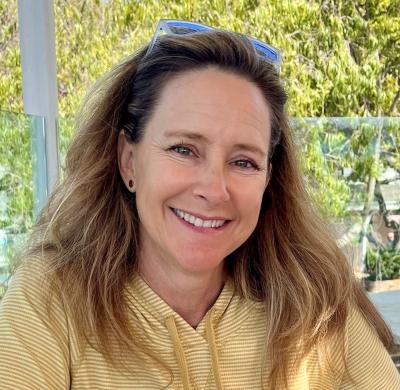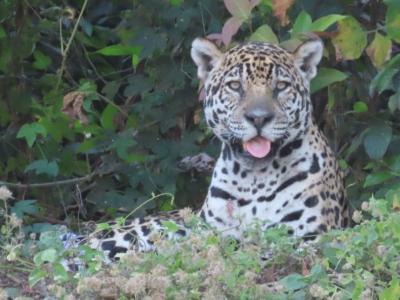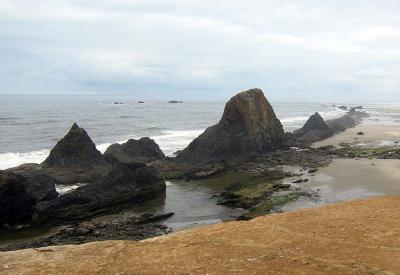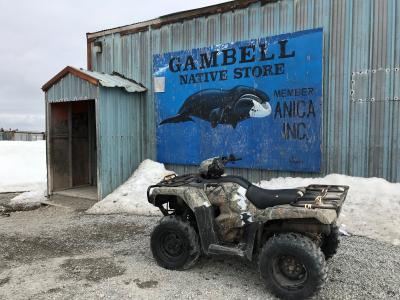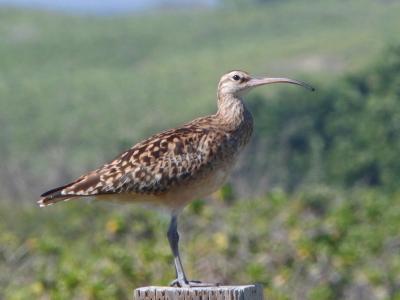Oregon in Spring
-
May 2027
Rich Hoyer
Tour Price to be Determined
2027
(2024 Price was $4,090)
Tour Price to be Determined
2027
(2024 Price was $4,090)
Oregon is well known for lush ancient forests and a picturesque coastline that teems with waterbirds. This is the Oregon west of the Cascade Mountains, where most of the human population resides. Less well known is how radically different the habitat and climate become as one moves south and east. In the “rain shadow” of the Cascades one finds dry, open conifer forests, desert-like shrub-steppe, and stark vistas of canyons and fault-block mountains, while farther south one experiences warm summers with virtually no rain. It’s this meeting of Pacific, Continental, and Mediterranean climates in astonishingly close proximity that gives the state of Oregon an avian diversity greater than any other area in the world at a similar latitude—especially in woodpeckers and owls. We’ll explore most of this diversity in scenic state parks on the coast, vibrant national wildlife refuges in the Willamette Valley, extensive coniferous forests on both sides of the Cascades and open expanses of sagebrush in the eastern deserts.
Oregon is well known for lush ancient forests and a picturesque coastline that teems with waterbirds. This is the Oregon west of the Cascade Mountains, where most of the human population resides. Less well known is how radically different the habitat and climate become as one moves south and east. In the “rain shadow” of the Cascades one finds dry, open conifer forests, desert-like shrub-steppe, and stark vistas of canyons and fault-block mountains, while farther south one experiences warm summers with virtually no rain. It’s this meeting of Pacific, Continental, and Mediterranean climates in astonishingly close proximity that gives the state of Oregon an avian diversity greater than any other area in the world at a similar latitude—especially in woodpeckers and owls. We’ll explore most of this diversity in scenic state parks on the coast, vibrant national wildlife refuges in the Willamette Valley, extensive coniferous forests on both sides of the Cascades and open expanses of sagebrush in the eastern deserts.
Day 1: The trip begins at 6 p.m.with a meeting in the lobby of our Portland airport-area motel. Night in Portland.
Since Rich is from Oregon his enthusiasm for the area was infectious. We ran into birders he knew everywhere we went and they shared what they had been seeing. I loved that he was just as excited to see a pronghorn, gopher snake or Anise butterfly as the birds. I felt like it was more than just a birding trip.
Kristi Shaw, May 2019
Days 2-3: Driving toward the coast we’ll stop by wetlands where Wood Duck, Cinnamon Teal, Virginia Rail and Marsh Wren are common breeders. We’ll check for any lingering winter visitors, which might include Cackling Goose, Lesser Scaup or Bufflehead before entering the forested coast range for the remainder of the morning. Our stops may reveal Red-breasted Sapsucker (this tour could be called “woodpeckers and owls”; we see at least 11 of the former and seven of the latter most years), Western Flycatcher, American Dipper, Hermit Warbler, and Rufous Hummingbird before we pass through mossy and ferny grottoes and arrive in the dairy pastures of the coastal lowlands. At the coast we’ll check some productive sewage lagoons and the north jetty of Tillamook Bay before ending up at our hotel with a fabulous view over the mouth of Netarts Bay.
Our home base is on the Three Capes Scenic Route, and we’ll bird the headlands of Cape Meares, Cape Lookout and the various beaches and bays in between. We’ll carefully scan the sea stacks among multitudes of breeding Western Gulls, Brandt’s and Pelagic Cormorants, Common Murres and Pigeon Guillemots for the rarer Tufted Puffin, while Rhinoceros Auklet and Marbled Murrelet are more likely to be found on the water. Any exposed tidal rocks could harbor Black Oystercatchers or a late migrant Wandering Tattler or Black Turnstone. The forest-covered headlands are home to Pacific Wren, Steller’s Jay, Varied Thrush, and Hairy Woodpecker. Brush Rabbit and Townsend’s Chipmunk often forage in the open near the headland lighthouses, and the Margined White butterfly flits along the roadsides even in the typically cool coastal climate. The fine restaurant where we have our dinners is located in sight of Three Arch Rocks National Wildlife Refuge, home to one of the largest seabird colonies in the U.S. south of Alaska. Nights in Netarts.
Day 4: On our last morning on the outer coast we’ll bird our way southward along the coast, past places with native North American names such as Kiwanda, Nestucca and Siletz, and stop at a low headland for some light seawatching, where possibilities include Brown Pelican, Sooty Shearwater, and scoters. We’ll also include a stop at Yaquina Head, where Miocene lava flows have weathered to create rocks ideal for seabird colonies seemingly within arm’s reach of the historic lighthouse. In the afternoon we’ll drive east over the central Coast Range into the Willamette Valley. Night in Corvallis.
Day 5: Although the Willamette Valley is the most agriculturally productive region in the state (with such diverse crops as wine grapes, irises, berries, filberts, grass seed, peppermint and Christmas trees), the riverine forests are well protected and three major national wildlife refuges (Baskett Slough, Ankeny and Finley) are within driving distance. California Scrub-Jay, Black-headed Grosbeak, Violet-green Swallow and Vaux’s Swift are examples of common breeding species, and the improved wetlands at the refuges have recently hosted such surprises as Black-necked Stilt, breeding Wilson’s Phalarope and breeding Black Tern. The large cottonwoods and riparian thickets along the Willamette River are home to Pileated Woodpecker, Willow Flycatcher and the sometimes spotless oregonus race of Spotted Towhee. If the weather cooperates, we’ll drive to the meadow-capped top of Mary’s Peak, at 4,097 feet the highest point in the Coast Range, where one can often see and even hear the Pacific Ocean 27 miles away. Northern Pygmy-Owl, Hammond’s Flycatcher, Sooty Grouse, and Mountain Quail are common here (though the latter two are sometimes only heard), and we may find something more unusual such as Townsend’s Solitaire or “Oregon” Canada Jay (the dusky obscurus subspecies). The regenerating clearcuts in the foothills can also be surprisingly productive and offer prime habitat for Wrentit, MacGillivray’s Warbler, Yellow-breasted Chat, and Lazuli Bunting. An evening outing to some woodlands not far from town could yield Western Screech, Great Horned, Barn, or Barred Owls. Night in Corvallis.
Day 6: Following the South Fork of the Santiam River into the western foothills of the Cascade Mountains we’ll stop to admire the lovely, rushing mountain streams while eyeing the boulders for locally breeding Harlequin Duck, while a higher elevation lake usually hosts breeding Barrow’s Goldeneye. As we climb the higher mountains and cross the divide, the habitat changes abruptly and dramatically, from a dripping, dense fir-hemlock rainforest to Lodgepole Pine on lava flows only a few thousand years old, to a dry, open Ponderosa Pine-Western Juniper woodland punctuated by willow- and aspen-lined streams. In these drier east-side forests we could see Red-naped Sapsucker, Pygmy Nuthatch, Green-tailed Towhee, and “Thick-billed” Fox Sparrow; one site has had reliable Calliope Hummingbird territories for decades. The volcanic peaks of the Three Sisters, Mount Bachelor and Broken Top will provide a breathtaking backdrop as we search for regional specialties such as Cassin’s Finch, Clark’s Nutcracker and a subspecies of White-breasted Nuthatch that differs noticeably from the one we may have seen in the western part of the state. A check of recent forest burns often reveals both Black-backed and Three-toed Woodpeckers. Night in Sisters.
Day 7: We’ll have another chance to look for some of the scarcer woodpeckers or other specialties of the pine forest before we head toward Prineville in the search for an active colony of Tricolored Blackbirds. This will be followed by a drive through the picturesque Crooked River gorge where White-throated Swift, Rock Wren, Canyon Wren, and Golden Eagle breed. After lunch we’ll drive eastward through ancient Western Juniper woodlands, home to Ash-throated Flycatcher, Pinyon Jay and Gray Flycatcher, and across the sagebrush steppe of the northern Great Basin, following the 10 million-year-old Brothers fault zone, the defining northern edge of the Basin and Range ecoregion. This time of year wildflowers can make a stroll through the normally drab sagebrush flats a delightful treasure hunt. We’ll end the day with a drive through wet meadows filled with waterfowl, Black-necked Stilts, American Avocets, Willets, and Wilson’s Phalarope. Night in Burns/Hines.
Days 8-10: We’ll have three full days to explore the watersheds of the Harney Basin. Malheur National Wildlife Refuge, which encompasses the heart of this landlocked basin as well as the Donner und Blitzen River valley to the south, is located only 30 miles south of Burns. Well-watered meadows and the shores of the Narrows on the way will distract us; Long-billed Curlew, Swainson’s Hawk, and various waterfowl are common roadside birds. Isolated oases of spruce, pine, cottonwood and elm planted around former ranches act as migrant traps and are often alive with recent arrivals. We’ll concentrate on such places, seeing expected migrants such as Western Tanager, Wilson’s Warbler, and Cassin’s and Warbling Vireos while hoping for the excitement of vagrant landbirds from eastern North America. The patch of trees at the refuge headquarters is one of the best such traps and has been responsible for many first and second state records. Locally breeding Bullock’s Orioles brighten up the treetops while California Quail scurry between the bushes, but much of the magic of Malheur (which doesn’t live up to its name—malheur means “misfortune” in French) lies in the extensive marshes, lakes and wet meadows. Flocks of White-faced Ibis, American White Pelicans, and Franklin’s Gulls pass between feeding and nesting areas on islands. Yellow-headed Blackbirds are numerous in the cattails while Sora and Virginia Rail are common but more often heard than seen. Sandhill Cranes share moist meadows with Bobolinks in the shadows of Steens Mountain, whose road is usually still snowed-in this time of year. We’ll also check the dry upland habitats for sage and juniper specialties such as Sage Thrasher and Sagebrush Sparrow, and we can always hope for a wandering Greater Sage Grouse on the roadside as we also keep an eye on the cliffs and rimrock for White-throated Swift and Chukar. A drive through the Alvord Basin will be wonderfully scenic, with Oregon’s driest desert stretching below to the right and Steens Mountain rising up 5600 abrupt feet on the left, and it’s the best area in the state to find Black-throated Sparrow.
On the day between trips south to the refuge we’ll venture north into the Silvies River drainage in the superb pine-fir-larch woods of the Ochoco and Blue Mountains. Here we have an excellent chance of finding Williamson’s Sapsucker, White-headed Woodpecker, “Slate-colored” Fox Sparrow, and Dusky Flycatcher, and we’ll make a special attempt for Dusky Grouse. We’ll also make an evening visit north of town to look for Flammulated Owl, which though difficult to see well, can be surprisingly common. Nights in Burns/Hines.
Day 11: Our drive back to Portland will take us west and north along the scenic John Day River, the second longest free-flowing river in the lower 48 states. Stops along the way may reveal migrants and breeders such as Red Crossbill and Townsend’s Warbler, and we’ll include a short stop in the John Day Fossil Beds National Monument for a picnic lunch.Once we reach the freeway east of The Dalles, we’ll head downriver through the rightfully famous Columbia River Gorge National Scenic Area, where the continent’s second largest river cuts right through the Cascade Mountains and waterfalls (such as Multnomah, the state’s tallest) and windsurfing opportunities attract many tourists. We’ll stop at Crown Point to enjoy a panoramic view of Lewis and Clark’s route before continuing to Portland. Night in Portland.
Day 12: The trip concludes this morning in Portland.
Note: The information presented below has been extracted from our formal General Information for this tour. It covers topics we feel potential registrants may wish to consider before booking space. The complete General Information for this tour will be sent to all tour registrants and of course supplemental information, if needed, is available from the WINGS office.
ENTERING THE UNITED STATES: Non-US citizens need a valid passport and may need a tourist visa. Consult your nearest U.S. Embassy or consulate for details. Canadian citizens should carry proof of citizenship in the form of a passport. If required by the embassy or visa-granting entity, WINGS can provide a letter for you to use regarding your participation in the tour.
PACE OF THE TOUR: Most mornings will start around 6:00 a.m. (a few will start earlier) and we bird most days through lunch until mid-afternoon. Every day we’ll schedule one to two hours off at the hotel before dinner, some days even a bit more, and on a couple long days we’ll head almost directly to dinner. On a few evenings we plan on optional owling after dinner (where having a small flashlight or headlamp will be necessary).
Our longest walks may be two miles round trip. One walk we may do depending on weather is a road that is almostly continually up to the top at Marys Peak at 4100 feet elevation; it is less than ½ mile each way, and a nice road (though closed to public traffic), but a walking stick would be useful. Most walking is done on roads and trails, although there will be some over uneven ground and possibly in marshy/dewy grass. Some days, especially travel days, we do more birding stops just outside the van. Sturdy footgear, waterproof if possible, is important, and a hiking stick is recommended for anyone with balance problems or weak knees. One should be prepared for long periods of standing and walking slowly, and a small travel stool is handy for those who find this tiring.
HEALTH: Oregon presents no real hazards to the visiting birdwatcher.
Insects: We will be in Oregon largely before the mosquito season, which if early can be a nuisance at Malheur National Wildlife Refuge but essentially never a problem west of the Cascades or high in the mountains. The leader will have enough repellent for all if it seems necessary.
Elevation: Some of our birding is at elevations of 5000 to 7000 feet, and while we do not schedule anything even faintly strenuous at these elevations, anyone with a history of cardiovascular or respiratory problems should be aware of the altitudinal stress. Please consult your physician.
Smoking: Smoking is prohibited in the vehicles or when the group is gathered for meals, checklists, etc. If you are sharing a room with a nonsmoker, please do not smoke in the room. If you smoke in the field, do so well away and downwind from the group. If any location where the group is gathered has a stricter policy than the WINGS policy, that stricter policy will prevail.
Miscellaneous: We actively look for reptiles, but the one species poisonous snake in Oregon is very seldom seen this early in the year.
High-elevation sun can be intense, making a broad-brimmed hat, proper clothing and a strong sun block lotion essential.
CLIMATE: Since we will be ranging from sea level on the humid coast to more than 7000 feet in the very dry rain shadow of the Cascades, we’ll experience a wide range of temperatures. Rain is likely on no more than a few days during this time of year, but one must always be prepared for the unexpected, including very cold and very hot temperatures. Even when it is hot inland (a heat wave can bring it to the upper 90’s °F), it can be quite cool, foggy and breezy on the outer coast, with high temperatures in the upper 50’s °F, and early mornings east of the Cascade mountains can even dip into the low 30’s (near freezing.) Since we may experience wide ranges of temperatures on the tour, be prepared with clothing for both cool and hot weather.
ACCOMMODATIONS: We will stay at standard, comfortable motels and/or lodges throughout the tour. Two of our hotels have indoor swimming pools; all have wireless internet and laundry facilities.
FOOD: We’ll have three picnic breakfasts during the first part of the tour; otherwise early breakfasts are provided by our accommodation. Nearly all lunches are delicious and varied picnics in the field. Dinners are mostly in nice, often excellent restaurants with a good selection of seafood and traditional meals, though menus are more conservative in the smaller towns of eastern Oregon.
Food Allergies / Requirements: We cannot guarantee that all food allergies can be accommodated at every destination. Participants with significant food allergies or special dietary requirements should bring appropriate foods with them for those times when their needs cannot be met. Announced meal times are always approximate depending on how the day unfolds. Participants who need to eat according to a fixed schedule should bring supplemental food. Please contact the WINGS office if you have any questions.
Water: Tap water is potable throughout. Fresh water will be available in the van throughout the tour.
TRANSPORTATION: We will be traveling by 15- (or 12) passenger window van or minivan, depending on the group size. When using 15-passenger window vans, we take a maximum of seven passengers plus the leader. Some roads may be quite bumpy and/or winding; anyone susceptible to motion sickness should bring an appropriate remedy. Participants should be able to ride in any seat in tour vehicles and are expected to change seats with others daily.
PHOTOGRAPHY: Scenery and memory shots will be plentiful and simple to obtain, but birds are difficult to photograph. This is undeniably a birdwatching tour, and all participants are expected to have binoculars and use them as their primary means of enjoying birds; Although there will be occasions when bird photography is possible, a birdwatching tour is not normally the best means of pursuing this aim, as excellent views of birds and further needs of the group don’t necessarily translate to the time needed for that perfect shot. Digiscoping, on the other hand, is perfectly compatible with the tour, though you must bring your own telescope; the leader’s scope will not be available for this purpose. Bring as many memory cards as you think you will use, as it may be difficult to find precisely what you need on short notice. Camera equipment should be packed in moisture- and dust-proof bags as a precaution.
2023 Narrative
In Summary
Our fabulous drive though the diverse corners of Oregon coincided with the most perfect stretch of weather imaginable. Never too cold, never hot, never too windy – just as Goldilocks ordered. We saw some wonderful birds and scenery along the way, with picnic lunches every day in idyllic settings. Among the 227 species we saw and heard, owls (six species), woodpeckers (11 species), and daytime raptors (14 species) stood out among the highlights. Favorites also included Mountain Bluebird, Sandhill Crane, Clark’s Nutcracker, and Black-billed Magpie east of the mountains, while on the coast we saw Tufted Puffin at two of their few breeding colonies, Brandt’s Cormorant in their full breeding colors, Wandering Tattler, and Rhinoceros Auklet.
In Detail
With little problem navigating the early morning weekday traffic right through the middle of Portland on our first day, we arrived at the very birdy Fernhill Wetlands on a beautiful morning. We soon spotted a stunning male Cinnamon Teal among the many Mallards and Gadwall, while at the same time a pair of Virginia Rails foraging in the open. Rich’s friend notified us of a Clark’s Grebe, which we eventually saw well; we were lucky to be present when a small group of the locally very rare Forster’s Terns flew in and then vanished; they were the first record for this heavily birded spot, but no one else ever saw them again. One of the prize sightings of the day was a pair of Bushtits actively building their nest, perhaps a second attempt at this late date. It was unusual to have had four Cackling Geese lingering this late with the abundant resident Canada Geese. With some birding in the Coast Range, where a pair of young American Dippers were being fed by a parent and a re-growing clearcut yielded MacGillivray’s Warbler and Willow Flycatcher, we soon found ourselves on the coast at Cannon Beach. The weather couldn’t have been nicer, so we didn’t mind having to wait a while to have a Tufted Puffin fly over. We eventually watched one land on Haystack Rock and had great views in the spotting scope. Later in the afternoon a friendly worker let us into the Nehalem Sewage pond, which was surprisingly void of birds, and so we had a timely arrival at our hotel with a fabulous view of the Netarts Bay mouth.
Our day in the Tillamook area began with picnic breakfast with the same sublime view of Netarts Bay in very inviting weather. We began our birding in earnest at Cape Meares Lighthouse, where territorial Hermit Warbler and Golden-crowned Kinglet came out of the trees, while a very cheeky pair of Wrentits boldly hopped around on a fence railing before disappearing into the dense salal thickets. All the way around to other side of the cape, we checked out the surf and bay of Bayocean Spit, finding low tide and very distant birds; Goodspeed Rd wasn’t very active either, but a check of the Barview Jetty was certainly worth it for the close views of Rhinoceros Auklet in the channel. The number of Pigeon Guillemots here was also quite the sight. It was a bit warmer inland at Kilchis River campground, perfect for a picnic lunch with Margined Whites flitting about in the understory and Western Tanagers and Black-throated Gray Warblers in the trees above. A female Bullock’s Oriole here was a surprise and quite rare in the county. A motionless Douglas’s Squirrel, also known as Chickaree, sat calmly at close range in a small shrub. We took the scenic drive back to Netarts via the WWII-era dirigible hangar and a back road that resulted in a memorable sighting of a very responsive Northern Pygmy-Owl. After dinner we returned to the Cape Meares Lighthouse area and patiently waited until it was dark enough for a Northern Saw-when Owl to finally respond to whistles, when it came in quite close several times for fabulous views of this often difficult to find species.
With the same gorgeous breakfast setting, but the occasional, very light (and almost comforting) mizzle, we began our third birding day with a few Red Crossbills of Type 10 in their favored Sitka Spruce behind the hotel. Little did we know that these would be the only crossbills on the entire tour, a record low count. A short stop down the road proved that the group of previously reported American White Pelicans (very rare on the coast) was still on Netarts Bay, and then a stop at the Lookout Point trailhead resulted in handsome Varied Thrushes with their wonderful, eerie songs. Sitka Sedge State Park gave us several Steller’s Jays as well as a few lingering migrant Whimbrel. We then worked our way down the coast with several stops, spotting a Gray Whale at Boiler Bay, the best spot on the coast to see them close to shore. After the seabird breeding spectacle at Yaquina Head, we were still missing a couple of target birds, so we drove all the way south to Yachats. There we found both Marbled Murrelet and Wandering Tattler, and after declaring victory, made our way inland to Corvallis.
The very top of Marys Peak was shrouded in fog in the early morning, but the important stretch of road was not, and so we were successful in our search for Sooty Grouse on the road, seeing a male and a female very well. Golden-crowned Kinglet was one of the few species we saw near the top of the mountain in the lovely Noble Fir groves that surrounded the wildflower-covered meadows. Mountain Quail remained heard-only, but the tour’s second Northern Pygmy-Owl responded nicely for great views as it flew back and forth over our heads and perched a few times for scope views. After a check of the Philomath sewage ponds, where a lone Greater White-fronted Goose was unusual, we lunched at Bellfountain County Park, a very birdy little spot. Red-breasted Sapsucker, Cassin’s Vireo, and Hutton’s Vireo were highlights here. We had time to quickly check a couple spots at Finley National Wildlife Refuge, with stops on the entrance road producing our first Yellow-breasted Chat and Acorn Woodpecker. On the refuge, Cinnamon Teal and Yellow-headed Blackbird were the main highlights. We attempted owling at a couple local parks after dinner, but for some reason, no one wanted to respond this evening.
Before departing the Willamette Valley, we tried once more at the restored native prairie south of Corvallis, seeing the local subspecies of Horned Lark and Lazuli Bunting, but dipping on the reported Grasshopper Sparrows for a second time. Passing through the verdant western slope of the Cascades we soon found ourselves in a very different habitat at high elevations. A quick highway stop resulted in a surprise Nashville Warbler, only later to find at least two more territorial birds on a back road; other birders were also noting the unusual abundance of them this year. More back road stops resulted in Green-tailed Towhee, Fox Sparrows (Thick-billed), and Lewis’s Woodpecker. We had our picnic lunch at a peaceful horse camp all to ourselves, and the birding highlights here were the mimicking jays – a Steller’s Jay mimicked Cooper’s Hawk (which was presumably in the area), while Canada Jay mimicked Rich mimicking a Northern Pygmy-Owl. We made another random stop where Gray Flycatcher and Pygmy Nuthatch were found, while a failed attempt to find a Least Flycatcher (which was apparently re-found the following morning by other birders) resulted instead in a spectacular sighting of Northern Goshawk, soon to be renamed American Goshawk. We made one final birding stop at a spring in an old burn, where White-headed Woodpecker was the highlight, though Western Tanager, Townsend’s Solitaire, Cassin’s Finch, and Cassin’s Vireo were among the many other birds attracted to the water.
Variety was added to our full day’s drive to Burns with a detour through the Prineville area with its very local nesting colony of Tricolored Blackbirds. When then worked our way up the scenic Crooked River Canyon. California Quail made us pause along the roadside, while likely-looking spots for Rock Wren, Canyon Wren, and White-throated Swift proved fruitful, but also bringing us Ash-throated Flycatcher and Black-throated Gray Warbler. After our picnic lunch in the company of Bullock’s Orioles, we commenced the long drive, dominated by Western Juniper and Tall Sagebrush. One of the latter hosted a nest of Loggerhead Shrike with several eggs, while a stop at a stand of old growth of the same yielded the hoped-for Sagebrush Sparrow. The otherwise monotonous drive was punctuated by wonderful sightings of Prairie Falcon and Ferruginous Hawk on powerpoles by the highway. We finished the day’s birding on the way to dinner with a drive past flooded meadows to become future hay fields, where Sandhill Crane, Yellow-headed Blackbird, and many ducks abounded.
Our full morning driving through Malheur National Wildlife Refuge began in the Silvies River Hayfields and a detour to see a Burrowing Owl. A Ferruginous Hawk was at its nest of many years, guarding at least one chick. The refuge headquarters was alive with many migrant Bullock’s Oriole, Western Tanagers, and Warbling Vireos, among nearly 50 other species at this one stop. We rather wandered around on our own, so most of us missed but were happy to hear about the amazing sight of a Long-tailed Weasel climbing a tree and robbing a cavity of European Starlings of a couple nestlings. After headquarters we spied Eared Grebes at Buena Vista and Eastern Kingbirds and Bobolinks in the southern part of the Center Patrol Road. We returned via the scenic Diamond Craters where Lark Sparrows flirted in front of the van and Say’s Phoebe was in the crater. A Common Raven occupied a nest in the middle of the historic Pete French round barn. We then completed the loop drive along the well-naped Raptor Alley, where Ferruginous Hawk was a highlight – though the numbers of other raptors were impressive, including Golden and Bald Eagles and Red-tailed and Swainson’s Hawks. An after-dinner trip to Radar Hill just outside of town located good numbers of mosquitos, but it also didn’t take us long to see the first of a few Common Poorwills at this very reliable location.
We spent a lovely day in the richly diverse coniferous forests of the Blue Mountains north of Burns. Our first stop at the Swick old growth grove was a lucky one, with a single, silent Clark’s Nutcracker appearing while we were watching our first Williamson’s Sapsuckers. It turned out to be the only one of the trip; the bulk of the species’ population is presumably off with the crossbills, which were notable by their utter absence. The stakeout spot for Slate-colored Fox Sparrow on Murderers Creek Road was as reliable as ever. Some Canada Jays appeared after the male sparrow went back to his singing and the female fed casually nearby under a bush. We should have been on the alert when the jays mimicked Sharp-shinned Hawk – or rather, the sparrows should have. After a brief commotion in the shrubs, we looked to see a real Sharp-shinned Hawk emerge with the female Fox Sparrow in its talons. It was about as surprised as we were but managed to hang onto its meal as it quickly vanished into the woods. We stopped when a Lincoln’s Sparrow was heard through the van window, and we finally coaxed a very shy bird to be more assertive in defending its territory. No Dusky Grouse graced the road to the top of Aldrich Mountain, and we were stopped less than two miles from the top by a lingering snow drift (as well as some splendid wildflowers, such as yellow fritillary). We did see some lovely Mountain Bluebirds and Cassin’s Finches here, while farther back down the road Ruby-crowned Kinglet, Townsend’s Warbler, and Columbian Ground-Squirrels were highlights. We added some ducks with a quick stop at Yellowjacket Lake, including a handsome drake Green-winged Teal. For variety, we took pizza to go to have in the presence of the Great Horned Owl family at Malheur NWR HQ, along the way passing by some wet meadows with American Avocet, Black-necked Stilt, and Yellow-headed Blackbird on fenceposts very close to the road.
Our last full day in the Great Basin was dedicated to traversing one of the most remote corners of the state, though on this Memorial Day weekend, the amount of traffic was impressive. We started with picnic lunch at Frenchglen where we saw a gorgeous male Rose-breasted Grosbeak, a nice eastern vagrant to Oregon. Photos showed that we overlooked a female of the same species, foraging with it and some female Black-headed Grosbeaks, but later other birders saw it as well as a second male. Just up the road we managed to coax in a pair of Blue-gray Gnatcatchers and then then had to make a photo stop for the amazing show of lupine, phlox, and balsamroot in the Catlow Valley. A Chukar perched on the rimrock above the highway vanished before everyone could see it, but some patient playback brought the bird back out for excellent views. We managed to include a short stop at Cottonwood Creek, where we had great views of Lazuli Bunting among the many migrating Western Tanagers. At the Fields Oasis, an adult and juvenile Great Horned Owl were highlights, but they were eclipsed when we spotted a female Western Screech-Owl poking her head out of nest cavity and tooting back in response to Rich’s imitation; the male tooted back as well, though invisibly from a dense cottonwood. The awe-inspiring views of Steens Mountain and the Alvord Basin were broken up by at least three territorial Black-throated Sparrows, some fabulous wildflowers, a Leanira Checkerspot, and a Long-nosed Leopard Lizard. On the last leg of our drive, the Raptor Alley was again very good with our best views of Prairie Falcon ever.
Our final day’s long drive back to Portland was first punctuated by some fruitful stops along the S Fork John Day River, where we had great views of sparkling blue Lazuli Buntings, Eastern Kingbird, and a large group of Bighorn Sheep, including several lambs up on the steep slopes. We enjoyed our time at the scenic John Day Fossil Beds National Monument, even finding a Chukar from the parking lot. From then on it was only short roadside stops, but at one we had a Golden Eagle on one side of the road and heard a young one on the other, and then realized there was a huge nest in a Ponderosa Pine; nest trees are much rarer than cliff nests in Oregon. A quick afternoon rest stop yielded a confiding Ash-throated Flycatcher, and countless Horned Larks adorned the fences as we drove through wheat country and wind turbine generator fields. One last birding stop before the freeway driving resulted in a fantastic Peregrine Falcon display, a bird seeming to just play in the wind along the Columbia River. We finished the long drive arriving at Multnomah Falls, a very beautiful spot though we had to wade through perhaps the largest throngs of tourists this place would see on any single day of the year, thanks to the federal holiday weekend. Thanks to eBird, it was easy to see that we tallied 227 species in the 10 days that we covered 2122 miles of beautiful Oregon scenery.
Richard Hoyer 2023
Rich went way beyond his call of duty. He not only shared his knowledge of the birds, he was exploding with information of the volcanoes that had erupted in Oregon thousands of years before, and how the terrain as we saw it came about. He knew out of place quaint restaurants which he took us to, that added atmosphere to the venture.
- Dorothy M. on Oregon in Spring
Maximum group size is seven with one leader.





































